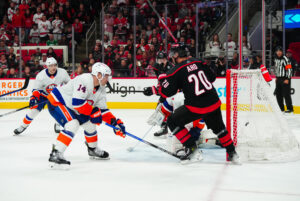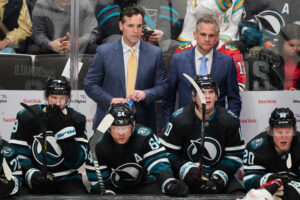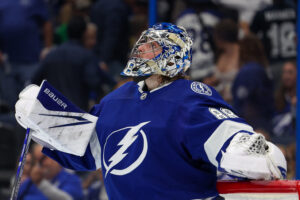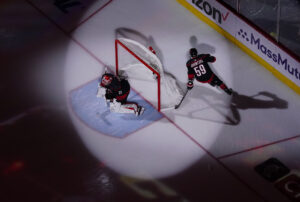Player development seems to always result in more questions than answers. How likely is it for a top pick to pan out? What makes a player a “steal”? Last Word On Hockey will be starting a new series on how to properly develop prospects from all different spots throughout the draft. This week’s piece involves top-10 picks and how they were used early in their careers.
Player Developments of Top 10 Picks
In the span of 2005 through 2015, there were 40 total selections made between fourth overall and tenth overall on forwards playing in North America. Of those 40 selections, three players were deemed not close to being NHL-ready after two additional seasons outside of the NHL following the draft. Those players were Devin Setoguchi, Jack Skille, and Kyle Okposo.
Player Development of Devin Setoguchi
Setoguchi, drafted eighth overall in 2005 by the San Jose Sharks, started with the Saskatoon Blades of the WHL. In his DY-1 season, Setoguchi played 66 games with 13 goals and 18 assists for 31 points. That was good enough for 0.47 points per game, ranking 34th out of the aforementioned 40 forwards drafted in DY-1 production. He followed that up with 33 goals and 31 assists for 64 points in 69 games in his DY. That was good for 0.928 points per game, ranking 36th out of 40 forwards for DY production.
After getting selected by the Sharks, Setoguchi would stay an additional two seasons in the WHL. In his DY+1 season, he would score 36 goals and 47 assists for 83 points in 65 games with Saskatoon. That was a rate of 1.277 points per game, ranking 21st out of 30 forwards outside the NHL in DY+1 production. After not receiving a call-up after a solid season of production, he would return to the WHL. This time, he played with the Prince George Cougars, as an assistant captain. Setoguchi scored 36 goals and 29 assists for 65 points in 55 games, a 1.182 points per game pace. That ranked eighth out of 12 forwards still outside the NHL in DY+2 production. Following that season, Setoguchi would finally see NHL action.
How Was Setoguchi Used?
In his first professional season, Setoguchi would play 44 NHL games to 23 AHL games. In the 23 AHL games, he scored eight goals and 11 assists for 19 points, a decent outing for a rookie. Meanwhile, in his 44 NHL games, he would score 11 goals and six assists for 17 points. He did that while averaging 14:15 time on ice per game. His advanced stats were solid as well, showing a promising future. He was decent at even strength, with even-strength offence goals above replacement (EVO) of 2.4 and even-strength defence goals above replacement (EVD) of 1.3. Meanwhile, his overall analytics were also strong, with wins above replacement (WAR) and goals above replacement (GAR) of 0.3 and 1.9, respectively.
In his second year, he would play 81 games at the NHL level, recording 16:13 time on ice per game. With that solid jump in ice time, Setoguchi went on to produce 31 goals and 34 assists for 65 points, a fantastic second-year jump. Analytically, his EVO (9.1), WAR (3.6) and GAR (20) all saw significant jumps along with his counting stats. However, his EVD dropped below replacement-level at -2.4, but he showed immense offensive upside nonetheless.
Poor Player Development Leads to a Step Back
Following a fantastic season, Setoguchi would play 70 total games, all in the NHL. However, despite proving to be a more than capable player in a relatively big role, the Sharks would regress his ice time. He dropped to an average of 15:18 ice time per game, nearly a full minute less per game. That dip in ice time led to his production also dropping, as he recorded 20 goals and 16 assists for 36 points. As for his analytics, they also regressed. His EVO dropped to 0.7 while his EVD remained below replacement-level at -1.5. Meanwhile, both his WAR and GAR regressed heavily to 1.4 and 7.8, respectively.
Setoguchi has since retired, having last played in the DEL, Germany’s top men’s league, in the 2017-18 season. Following his third NHL season, Setoguchi would not see more than 42 points in a single season following his sophomore break-out. He would leave the Sharks organization after his fourth season, joining the Minnesota Wild for two years. After those two years, he would play for the Winnipeg Jets for a season before joining the Calgary Flames for a cup of tea.
After his time in the Flames organization, Setoguchi left for the NLA, the top Swiss league, for a year, before making his NHL return with the Los Angeles Kings for one season. In his career, he played 516 games with 131 goals and 130 assists for 261 points, all while averaging 15:13 time on ice per game. It’s clear that Setoguchi’s player development was poorly executed by the Sharks. However, his player development may be better than the next player we will look at.
Player Development of Jack Skille
Skille, drafted seventh overall by the Chicago Blackhawks in 2005, is a retired winger with over 350 games played across five NHL teams. It all started in his DY-1 season, playing for the U.S. National U17 team in the USDP, scoring 14 goals and 10 assists for 24 points in 33 games. That was enough for a 0.727 point-per-game pace, ranking 29th out of 40 forwards in DY-1 production. The following season, in his DY, Skille played for the USNTDP U18 team in the USDP, scoring nine goals and 11 assists for 20 points in 26 games. That rate was good for 0.769 points per game, ranking dead last among those same 40 forwards in DY production.
Skille would join the NCAA with the University of Wisconsin in his DY+1 season, where he would score 13 goals and eight assists for 21 points in 41 games played. That mark would be enough for 0.512 points per game, ranking dead last again, among 30 forwards not yet in the NHL for DY+1 production. Playing one last season in the NCAA, Skille would record eight goals and 10 assists for 18 points in just 26 games played, good for 0.692 points per game. That mark ranked ninth out of 12 forwards not yet in the NHL in DY+2 production. He would be a part of the NHL with the Blackhawks following his second NCAA season.
How Was Skille Used?
In his first taste of professional hockey, Skille would play 16 NHL games and 59 AHL games. In those 59 AHL games, he would produce 16 goals and 18 assists for 34 points, a decent mark for a young player. Meanwhile, in the 16 NHL games, Skille would record three goals and two assists for five points. He averaged 11:59 time on ice per game in his short NHL stint, with his analytics being relatively good. All of his advanced stats were above replacement level, with his EVO and EVD landing at 0.7 and 1.5, respectively. Meanwhile, his WAR and GAR were also solid, at 0.4 and 2.3, respectively.
Despite a surprisingly decent performance in a small sample, Skille would play fewer games at the NHL level in year two, appearing in just eight games with one goal, averaging a measly 9:26 time on ice per game. In the AHL, he would play 58 games, scoring 20 goals and 25 assists for 45 points, yet again a solid mark. His NHL analytics regressed to below replacement level, but it’s difficult performing well with the lack of ice time and games played Skille saw. Recording an EVO of -1.1 and an EVD of -0.4 paints that picture, while his WAR was at -0.1 and his GAR was down at -0.6.
Never Given a Shot
In his third season, Skille was simply never given a chance, playing in even fewer games with less ice time. Playing in just six NHL contests with an average of just 7:40 per game, it’s clear he had a rough time. Meanwhile, at the AHL level, Skille played 63 games with 23 goals and 26 assists for 49 points, showing at least some promise for the third consecutive season in the minors. Due to his lack of playing time at the NHL level, his analytics were not available for this season. However, evidence from his first two seasons suggests that he was unfairly restricted by the Blackhawks and never given a fair chance.
After that third season, he would play entirely at the NHL level with the Blackhawks for 49 games. He scored seven goals and 10 assists for 17 points, before being dealt to the Florida Panthers. With the Panthers that season, he played 13 games with two points. He would play for the Panthers, Columbus Blue Jackets, Colorado Avalanche, and Vancouver Canucks over the next six seasons. In that time, he combined for 221 games played, with 25 goals and 23 assists for 48 points at the NHL level. In that same span, he played just 22 AHL games with 13 goals and 11 assists for 24 points. Following his time with Vancouver, he would leave the NHL for the KHL for a year. He has since bounced around from Switzerland (NL), Germany (DEL), and Austria (ICEHL). Skille’s player development was simply not good enough. The Blackhawks never let him sit at the NHL level for long enough through his first three seasons.
Player Development of Kyle Okposo
Okposo, drafted seventh overall by the New York Islanders in the 2006 NHL draft, has had a successful NHL career. The big forward from St. Paul, Minnesota was first on the map in his DY-1 season, playing high school hockey with the prestigious Shattuck St. Mary’s U18 prep. He recorded 47 goals and 45 assists for 92 points in 65 games that year. That point total gave him a 1.415 point-per-game pace. That ranked third out of those 40 forwards in DY-1 production, albeit in a weaker league than most. In his DY, he moved up to the USHL, playing for the Des Moines Buccaneers, scoring 27 goals and 31 assists for 58 points in 50 games. That scoring line gave him a 1.655 point per game pace. That ranked fifth out of those same 40 forwards in DY production, but again, in a weaker league than most. Due to him facing lesser competition, the Islanders gave him an additional two seasons in the NCAA.
Playing for the University of Minnesota in his DY+1 season, Okposo recorded 19 goals and 21 assists for 40 points in 40 games. He scored at exactly one point per game. That rate landed him 29th out of 30 forwards not in the NHL in DY+1 production. Due to a comparatively poor season, albeit in a much tougher league than before, he was given another season. He scored seven goals and four assists for 11 points in just 18 games. That gave him a 0.611 point-per-game pace, ranking 10th out of 12 forwards outside the NHL in DY+2 production. Getting into 35 AHL games that season as well, Okposo would see his first taste of consistent NHL action the following year.
How Was Okposo Used?
In his rookie campaign, Okposo would play 65 NHL games with 18 goals and 21 assists for 39 points. He averaged a solid 18:01 time on ice per game that season. He finished 14th in Calder trophy voting, per hockey-reference. His analytics were fantastic for a rookie, recording a solid EVO (3.7) and EVD (4.4), showcasing his reliable two-way abilities. Overall, his WAR (1.6) and GAR (8.9) showed just how valuable he was for the Islanders.
In his second NHL season, Okposo would see 80 games, with 19 goals and 33 assists for 52 points. That’s all while averaging 20:32 time on ice per game. His analytics at even-strength saw considerable regression. His EVO fell to 2.3 and his EVD dropped alarmingly low to 0.9. Meanwhile, his WAR (1.9) and GAR (10.5) were improved, showing his special teams impact.
Okposo Takes a Step Back
With the glaring regression in even-strength ability in his sophomore season, Okposo would see his ice time drop to 16:35 per game. That’s across just 38 contests. He would record five goals and 15 assists for 20 points in those games. A solid rate despite the step back in ice time. Analytically, his even-strength numbers improved, but his overall numbers dropped. His EVO and EVD returned to what his rookie numbers looked like (5.7 and 1.3, respectively). But his WAR (1.5) and GAR (8.1) came back down to Earth a bit.
Following his first three seasons, he would remain with the Islanders for five more seasons. In that span, he played 337 games with 95 goals and 158 assists for 253 points. He would leave the Islanders via free agency to sign a controversial deal with the Buffalo Sabres. His time there has not been great. From the 2016-17 season to the present day, Okposo has played 331 games with the Sabres. He scored 65 goals and 102 assists for 167 points. A history of concussions has somewhat derailed his career since joining Buffalo. However, the way the Islanders handled his player development was excellent. They deserve a lot of credit for how he would wind up becoming a solid NHLer.
Junior league stats via Elite Prospects, NHL stats via Hockey Reference, NHL analytics via Evolving Hockey
Main Photo:






